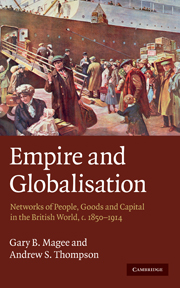Book contents
3 - Overseas migration
Published online by Cambridge University Press: 05 June 2012
Summary
Introduction
Migration was deeply woven into the fabric of British life. This was partly a function of numbers: the sheer – and unprecedented – scale of those who left the British Isles. More than that, it points to the fact that many people leaving the ‘old’ country were emphatically not cutting loose. A variety of networks helped migrants not only to move overseas and adapt to their new environments, but, crucially, to stay in touch and involved with the society they had left behind. Migrants, indeed, showed considerable determination and skill in forging and sustaining links to friends and family ‘back home’.
Return migration and modern technology contributed to this developing sense of a relationship between British people ‘at home’ and British peoples overseas. It is estimated that, from 1860 to 1914, as many as 40 per cent of all English emigrants came back to Britain – some two million returnees, each with first-hand knowledge of the colonies or the United States. Some returned for good, others temporarily – to marry someone from their former village, to attend the funerals of loved ones, or simply to see family and old friends. Meanwhile, by taking advantage of the transatlantic telegraph, and fast and reliable postal and remittance services, migrants were able, as never before, to keep abreast of what was happening in the United Kingdom, and to sustain family ties there.
The information that filtered through personal and familial networks was crucial to a migrant's choice of destination.
- Type
- Chapter
- Information
- Empire and GlobalisationNetworks of People, Goods and Capital in the British World, c.1850–1914, pp. 64 - 116Publisher: Cambridge University PressPrint publication year: 2010



